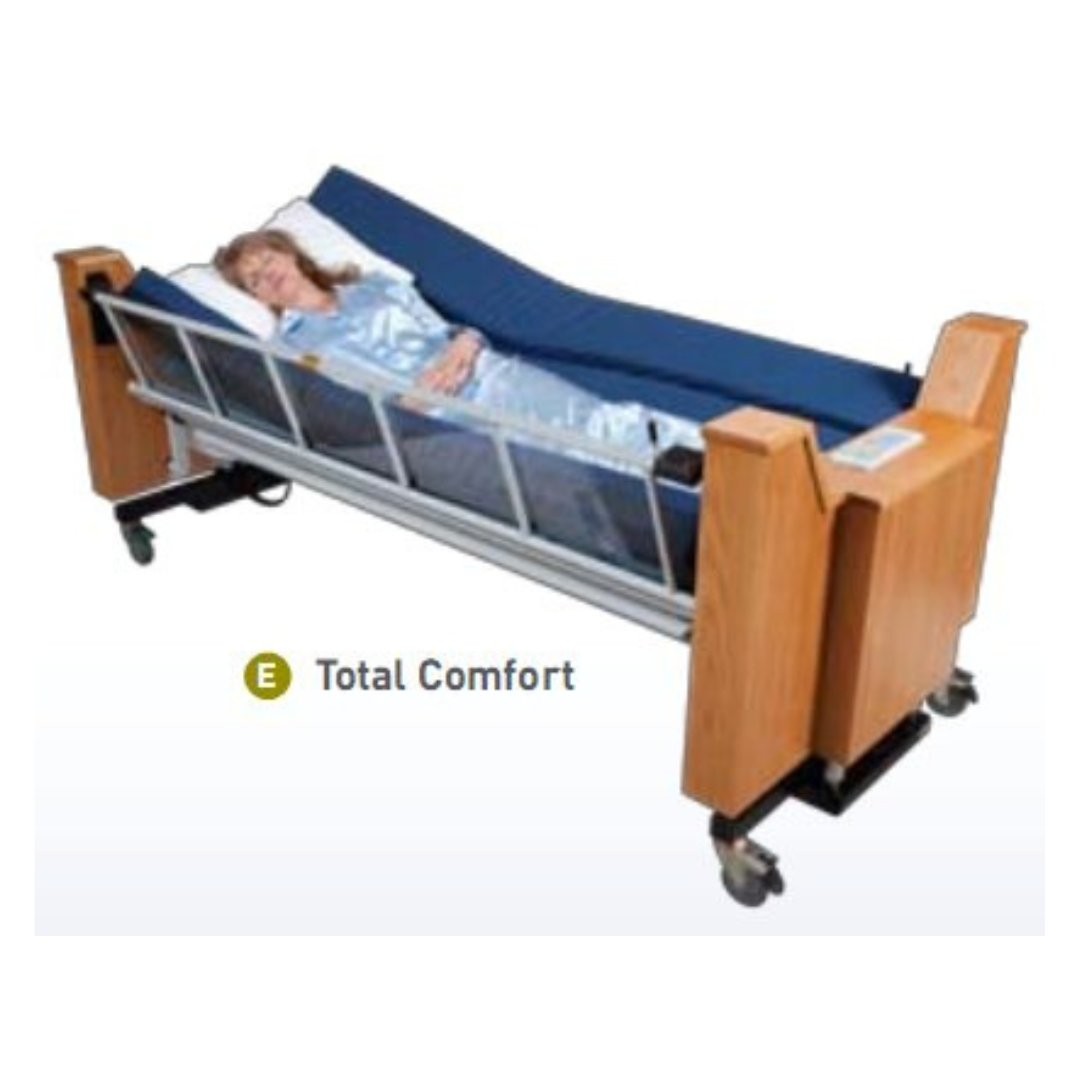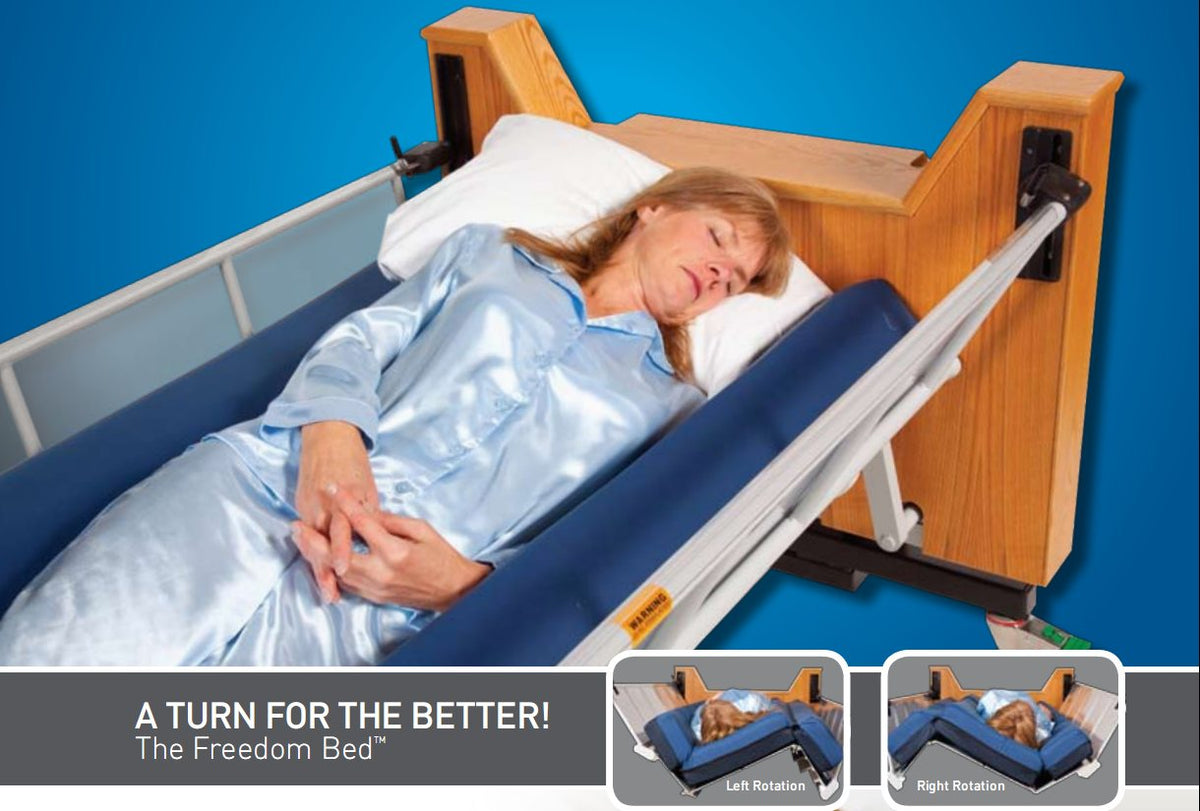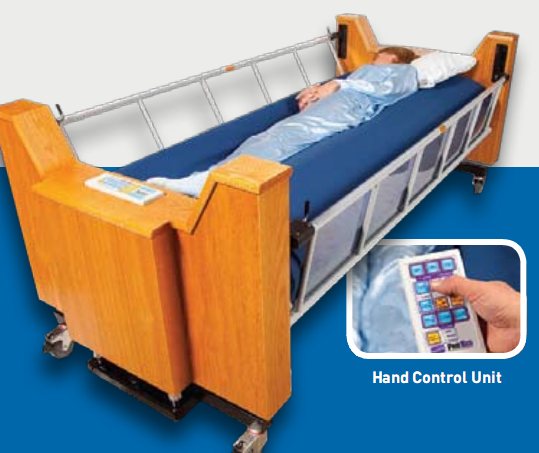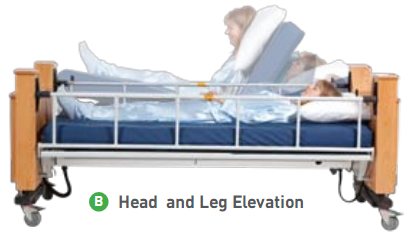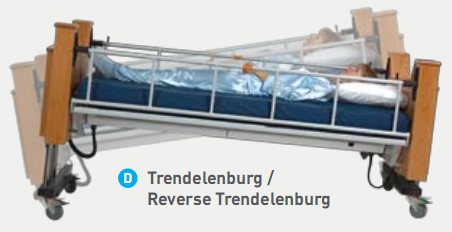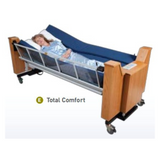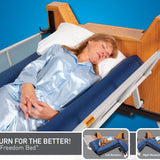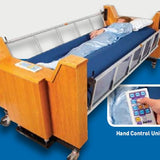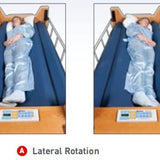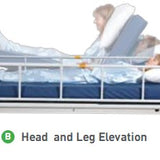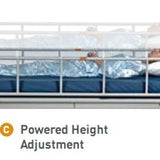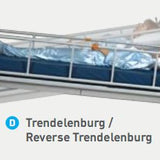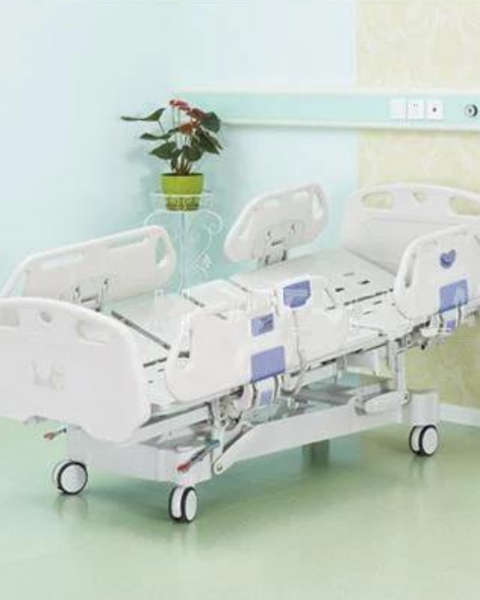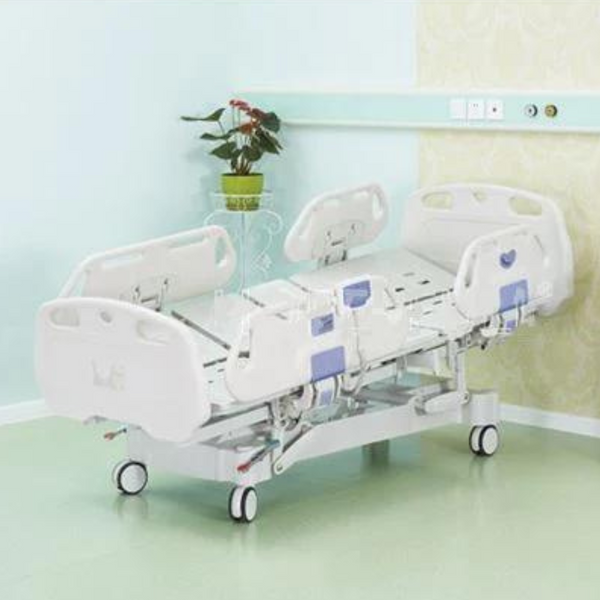Pro-Bed
Freedom Bed - Electric Lateral Rotation
EcF0981.p
Dhs. 169,426.00
-
Designed by the Disabled
for the Disabled -
100% Satisfaction
Guarantee -
Lowest Cost Shipping
Quoted in Cart
Replaced by our $12,000 Horizonal Lateral Rotation 5 Function Hospital Bed with Mattress and FREE Continental USA Shipping
Add optional Alexa Voice, Smartphone, or Switch Control and Automatic Scheduled Rotation, and Pressure Changing Low Air Loss Mattress. Call for more info. (302) 308-4008
Are you tired of
- Painful Bed Sores?
- Pneumonia and Other Respiratory Problems?
- Being Awakened for Turning?
Where Patient Comfort Meets Clinical Outcomes!
The Freedom Bed™
A BETTER way to care for the immobilized individual!
Models range from $20,000-$40,000 with a variety of options to accommodate unique needs.
Insurance Billing use E-1399 - Miscellaneous Durable Medical Equipment
- Lateral Rotation only (78 inch mattress)
- Lateral rotation + Head and Feet Elevation (78 inch mattress)
- Lateral Rotation + Powered High-Low Adjustable Elevation with Trendelenberg/Reverse Trendelenberg (78 inch mattress)
- Lateral Rotation + Head and Feet Elevation + Powered High-Low Adjustable Elevation with Trendelenberg/Reverse Trendelenberg (78 inch mattress)
- 86 inches Extended Length: Lateral Rotation + Head and Feet Elevation + Powered High-Low Adjustable Elevation with Trendelenberg/Reverse Trendelenberg
The Freedom Bed™ is a unique, computer-controlled, therapy system that manually or automatically turns the bed-user to different stable sleeping positions without the aid of caregivers or institutional staff.
The bed closely mimics the body's natural nocturnal motion by mechanically repositioning it in order to re-establish blood flow to compressed tissue and thus prevent the formation of life-threatening bedsores and other complications of immobility. The motion is timed (rather than random) when under computer control and the rate is adjustable to permit the accommodation of a wide variety of sleeping patterns. Clinical studies and testimonials confirm that the ultimate benefit of the Freedom Bed™ is better health and an improved lifestyle for bed-users and their caregivers.
 Note: Head board not shown |
 |
|
Note: Head board not shown |
How does The Freedom Bed™ work?
The horizontal surface of the bed that supports the mattress is hinged into three longitudinal sections. The user of the bed is positioned on his/her back in the centre of the three-part platform (the sleeping platform).
As the bed smoothly and quietly rotates to one side the outer section of the three-part platform on the lower side turns up to form a “wing” which supports the body along its entire length from the ankle to the shoulder. Thus the bed-user is carefully cradled by the bed’s structure to prevent sliding and shear forces that can increase the potential of developing bedsores. Any pressure transferred to this side of the user is thus dispersed along the entire frame of the body. The wing on the upper side of the platform lowers during this process to properly balance the entire platform and provide integral strength throughout the structure. As the bed reverses the rotation the lower wing rises as the higher wing lowers so that, at the horizontal position, all three sections of the platform are horizontal. The bed then automatically rotates to the other side to complete the cycle.
The design of the bed allows for the turning of the user along the spinal axis that creates a minimal feeling of rotation (turning). The slow rate of rotation, combined with the smoothness and quietness of operation, allows the user to enjoy uninterrupted sleep throughout the night.
Another feature unique to The Freedom Bed™ is the air-powered head and leg raising system that allows the user to be raised into the sitting position. The system is unique in that it can be adjusted to meet the requirements of each individual user of the bed rather than being built to accommodate the “average” person. The key benefit of the design is the low-pressure air cushions under the mattress that raise the user. These cushions of air conform to the users body shape, and provide a complete range of ergonomic positions. This also minimizes pressure under the sacrum thus reducing the risk of pressure sores developing while elevated.
 Automatic Operation
Automatic Operation
A key feature of the Freedom Bed™ is its ease of operation. User-friendly control panels allow caregivers to easily program the bed for automatic use or to adjust any of the bed’s operations manually. Changing the operation of the bed from automatic to manual or from manual to automatic is a one-step procedure. Additionally, an override button is available that allows users with minimal mobility to change the programming of the bed and to move from automatic to manual and vice versa. With the high number of features and functions available, there is also a system of safety “lock-outs” permitting the caregiver to determine the choice and number of functions that bed users may access from their control panel.
The functioning of the bed allows the user to be smoothly and quietly turned through a 60° range of rotation - from the horizontal position to up to 30° left and 30° right. Rotation can be programmed to stop at any position to meet the specific comfort and positioning requirements of the user. Additionally it allows the bed to “dwell” at the programmed position (left, center or right) for any period of time between one minute and a maximum of four hours. A typical turning schedule might be as follows:
- Horizontal for 30 minutes, then
- 23° right for 1 hour, then
- Horizontal for 30 minutes, then
- 27° left for 45 minutes
The program would automatically repeat with the next move being back to horizontal.
The ANGLES and TIMES are determined through consultation with the user’s caregiver and doctor and are influenced by a number of factors including user’s size, weight, skin condition and comfort levels and also by the primary reason for which the user requires turning (e.g. avoiding bedsores or improving respiration).
Applicable Medical Conditions
The clinically proven Freedom Bed™ is recommended for persons suffering from temporary or permanent immobility. This could include:
- Spinal cord injuries causing paraplegia and quadriplegia (with or without ventilator)
- Muscular dystrophy and multiple sclerosis
- Severe head injuries and stroke
- Severe respiratory ailments such as chronic obstructive pulmonary disease
- Immobility due to aging
- Cancer
- Guillain Barre Syndrome
- AIDS
- Coma
- Amputations
- Osteomyelitis
- Degenerative disk disease, post-spinal fusion and laminectomy
- Rheumatoid Arthritis
- ALS
- Any other condition where turning assistance is required
Tube Fed Patients
The torso raising position is also beneficial for tube fed bed users since the bed user can still be rotated with the torso raised up to 30°.
A higher elevation angle can be achieved by combining head elevation with Reverse Trendelenburg.
Be sure to review DETAILS tab for Resources such as recommended letters of medical necessity, articles, latest articles, and much more
Features
The many powerful features of the Freedom Bed™ have been designed with versatility and user friendliness in mind. These features have been designed to provide the ultimate in comfort and flexibility so that the bed-user or their caregiver can adjust the bed to meet their own individual needs. All mechanisms have been designed to operate as quietly as possible so that the bed-user is not woken up during their operation and particularly not during the night.
Lateral Rotation - Manual or Automatic Operation
The Freedom Bed™ has been designed so that the adjustable features of the lateral rotation system, that is dwell time and angle of rotation, can be set both manually or automatically through the bed’s user-friendly control systems. This allows the bed-user to set the bed to a customized turning schedule.
 Angle of Rotation
Angle of Rotation
The lateral rotation system provides for the user to be smoothly and quietly turned through a 60° range of rotation along the spinal axis. Turning from the horizontal position to up to 30° left and 30° right provides pressure relief and beneficial kinetic therapy. Rotation can be programmed to stop at any position to meet the specific comfort and positioning requirements of the user. A digital screen on the main control panel provides a read-out of the angle settings.
Dwell Time
The variable dwell time feature allows the bed user to determine how long they wish to stay at any of the three dwell positions (left, right and horizontal). Each position has an individual setting and can be set to the exact minute – between one minute and four hours per position.
Air-powered torso and leg raising systems
ProBed has developed a unique low air pressure torso and leg elevating system that provides an extraordinary level of comfort and versatility. The system works through the inflation of air cushions under the mattress that allows the mattress to conform to the bed user’s shape and provides a complete range of ergonomic positions.
 The torso system can effortlessly raise the bed user from anywhere between horizontal and 70°. This is an ideal position for eating, watching TV or reading. It also assists with patient care and wheelchair transfer. The torso raising position is also beneficial for tube fed bed users since the bed user can still be rotated with the torso raised up to 30°. A higher elevation angle can be achieved by combining head elevation with Reverse Trendelenburg.
The torso system can effortlessly raise the bed user from anywhere between horizontal and 70°. This is an ideal position for eating, watching TV or reading. It also assists with patient care and wheelchair transfer. The torso raising position is also beneficial for tube fed bed users since the bed user can still be rotated with the torso raised up to 30°. A higher elevation angle can be achieved by combining head elevation with Reverse Trendelenburg.
The leg raising system is ideal for bed users that obtain pain relief with their legs in an elevated position. The air pressure system for the legs has been designed so that the heels are supported in a low-pressure position when the cushion is inflated.
Powered Hi-Lo Elevation System
The powered Hi-Lo Elevation system allows the bed to be raised to an upper height of 34 inches or to a lower height of 22 inches when measured at the top of the mattress. The lower height supports transfer to and from a wheelchair and the upper height makes it easier to provide personal care to the bed-user.
Powered Trendelenburg/Reverse Trendelenburg Mechanism
 The powered Trendelenburg/Reverse Trendelenburg systems will tilt the bed by up to 10° in either the head-up or head-down direction. The head-down (Trendelenburg) position can be used for postural drainage for bed-users that have respiratory difficulties, whereas the head-up reverse Trendelenburg) position provides relief to bed-users with gastro-esophageal reflux, among numerous other things.
The powered Trendelenburg/Reverse Trendelenburg systems will tilt the bed by up to 10° in either the head-up or head-down direction. The head-down (Trendelenburg) position can be used for postural drainage for bed-users that have respiratory difficulties, whereas the head-up reverse Trendelenburg) position provides relief to bed-users with gastro-esophageal reflux, among numerous other things.
Safety Features
The bed user and caregiver’s safety have been very much in the forefront of the design of the Freedom Beds. A number of safety features have been built into the design. They are:
- 12 Volt DC power supply with on board charger and battery power to prevent the risk of shock and loss of operation as a result of power failures
- Movement sensors and “lock-out” capability to ensure safe positioning.
- For example the bed cannot be rotated if the head-raising system has elevated the bed-user more than 20° from the horizontal position
- A unique dynamic side-rail system that moves with the bed as it rotates.
- This design prevents any pinch or fall hazards to the patient.
- A stable transfer surface and height adjustment for movement in and out of wheelchairs and lifts
- Single touch buttons to position the bed user for CPR
- A single touch override button for bed-users capable of controlling their own positioning
Quality Construction
All components are of the highest quality. All moving parts use stainless steel pins housed in composite mounts that eliminate the need for scheduled maintenance. All fasteners are stainless steel. The bed frame utilizes strong lightweight aluminum and steel sections for long-term structural integrity. All finishes are a baked-on powder coat finish for durability and ease of cleaning.
The headboard and footboard are made of wood for aesthetic purposes and all drive components and mechanisms are totally enclosed in the headboard and footboard to provide excellent soundproofing and to ensure that there is no risk to the user or caregiver. The air-powered torso and leg raising systems are constructed from welded, clinical grade fabric and have undergone exhaustive testing and peer review.
Power Systems
The Freedom Bed™ is powered by a low voltage system (12 V DC) that eliminates the risk of shock to the bed user or their caregiver. The bed’s built-in batteries can power the bed for a number of days to continue repositioning in the event of power failures (the number of days varies depending on the turning schedule). A 12 V “smart charger” system ensures that the batteries are always fully charged. The Freedom Bed™ has CSA, UL544, and FCC approvals for its electrical systems.
Voice Control Option
The Freedom Bed is available with a Voice-Activated Control System, allowing every function of the Freedom Bed to be controlled by voice commands.
Low Operating Costs
The operating costs of the Freedom Bed™ are significantly lower than other options since regular maintenance or replacement of consumables is not required. In addition the use of DC power systems reduces power costs to about 3 to 5 cents per day or an economical $1.00 to $1.50 per month.
Warranty
The high quality construction of the Freedom beds allow us to offer the following warranty:
|
Mechanical and Electrical Components: |
3 years |
|
|
Mattress: |
2 years |
Warranty does not apply to woodwork, batteries, fuses or to any component which, in ProBed’s opinion, has been misused, altered, neglected or damaged by accident, presence of abnormal conditions of operation or handling.
Benefits
Benefits for the Bed User
The many features of the Freedom Bed™ provide a number of key benefits to immobilized bed-users such as:
- The automated turning process allows for more frequent turning to address the multi-system pathophysiological events associated with immobility. Also referred to as kinetic therapy, this turning not only provides pressure relief to prevent or treat bedsores but it can also produce, for example, a dramatic reduction in the incidence of respiratory problems and urinary tract and bladder infections
- Significantly better quality of sleep since the bed-user does not have to be manually turned during the night and is not woken up by the bed turning. This creates better mental clarity, better health and an improved lifestyle, free from dependence on caregivers during the night
- The opportunity to live in a home setting instead of an institution
- Pain reduction
- The bed can still rotate when the torso is in a raised position up to 20°. This can be added to the Reverse Trendelenberg position if suitable, for a maximum included angle of approximately 30° . A pillow adds more elevation again. This is of significant benefit to people who are tube fed
- Prevention or reduction of gastro-esophageal reflux
- Better respiratory health and clearance of upper respiratory and oral secretions
- Reduction in spasticity and abnormal toneImproved comfort
- Improved bowel regularity
- No dehydration and subsequent electrolyte imbalance since the bed creates no heat
Benefits for Home-Based Caregivers
The physical and mental tasks associated with caring for immobilized persons can place a considerable burden on spouses, parents, etc. The physical requirements of manually turning an immobile person frequently mean that family members become unable, through age and/or infirmity, to provide the required assistance. This results in institutionalization of the family member.
The Freedom Bed™ has been designed with the caregiver very much in mind and provides considerable benefits along with the ability to provide a significantly better quality of home-based care.
The Freedom Bed™ automatically turns the bed user during the night thus eliminating the need for the caregiver to get up every two hours. Sleep deprivation is considerably reduced and thus caregiver physical and mental fatigue are decreased
There is a reduced need to manually turn or reposition the user and thus a decreased chance of the caregiver developing neck, shoulder or back injuries
Head-raising and leg-raising system, and bed height adjustment assists in positioning the user for personal care and for transfer to and from a wheelchair
Benefits for Institutions Providing Care to Immobilized Patients
There are a number of significant benefits that accrue to institutions as a result of investing in the Freedom Bed™. These include:
- Increased productivity of nurses and facility support staff by reducing the amount of manual patient turning that is required. This allows staff members to use their time more effectively and productively in the care of their patients
- An effective way to treat or avoid pressure ulcers and other complications of immobility
- A method to protect healthcare personnel from debilitating back, neck and shoulder injuries (caused by moving or turning patients) that lead to considerable time off work and the associated costs of sick days, workers compensation claims, and hiring of replacement staff.
- Reduced Staff Turnover, reduces costs of recruiting, hiring and training, and of using more expensive staff when CNA’s not available
- Reduction in legal claims against healthcare facilities for bedsore development.
Cost Benefits to the Health Care Industry
For an industry struggling to get its costs under control the Freedom Bed™ offers significant savings by focusing on a strategy of prevention of the problems before they occur. It offers:
- Substantially reduced direct medical expenditures associated with repeat hospital admissions to treat pressure ulcers and other complications of immobility such as bladder and respiratory infections. It has been found that prevention of bedsores is 2.5 times less expensive than treatment - Oot-Giromini (1989)
- Support for a de-institutionalizing strategy that allows chronically immobilized patients to be moved from hospitals back to their homes (or to assisted living environments)
- Avoidance of costly readmissions from bedsores or other systemic complications
- A method to reduce the length of hospital stay for specific groups of patients. Treating critically ill patients with kinetic therapy has been shown to reduce intensive care stays by 24 percent. The movement helps reduce risk of infection and complications from pneumonia and other respiratory problems that affect about 20 percent of intensive care patients. A study in 1987 that was published in the journal “Stroke” showed that the risk of infection for stroke patients placed on normal hospital beds was 2.9 times greater when compared with a study group of patients placed on rotating beds (Stroke 18, No 3 May-June, 1987).
- Significantly reduced costs of compensation claims for nursing and support staff injured during repositioning or transferring of immobilized patients. In a study conducted for the Workers Compensation Board of British Columbia in 1996 it was found that manual lifting, transfer or repositioning of residents (without assistance from mechanical aides) was responsible for 63% of all back, neck and shoulder injuries.
- Substantially reduced time lost by nursing and support staff from neck, back and shoulder injuries. Reduces the problems of finding replacement staff.
- Significantly reduce the number of staff involved in turning patients (particularly during the night). This will reduce costs and allow staff to focus on providing a significantly higher quality of care.
Complications of a Mobility
Bed Turning, Pressure/Decubitus Ulcers and More
A mobile person generally turns approximately once every 10-12 minutes while sleeping. This action provides for healthy blood circulation, stimulation of body organs and movement of body fluids. When a person becomes temporarily or permanently immobilized, however, the blood supply to that part of the body that is under pressure is restricted. If that pressure is not regularly relieved, and the blood supply restored, the affected tissue dies and sloughs off and a pressure or decubitus ulcer (i.e. bedsore) begins to form. These occur most commonly on the buttocks, sacrum, hips and heels and can be life-threatening if they become infected.
If that isn’t bad enough there are many other medical complications associated with immobility. These include:
- Pneumonia
- Venous stasis
- Thrombosis
- Embolism
- Stone formation
- Urinary tract infection (kidney and bladder)
- Muscle wasting
- Bone demineralization
- Atelectasis
Decubitus Ulcers (or Bedsores)
Decubitus ulcers are of major concern to the sufferers, their caregivers, and the medical community. The scale of the problem is immense. It is estimated that approximately 1.2 million people are suffering from bedsores at any one time in the United States alone and almost 70% of sufferers are over 65. It is reported that there are 60,000 deaths annually from complications arising from bedsores and the current cost to the US Health Care System to treat these and other associated conditions is estimated at anywhere from US$15 - $40 billion annually.
Traditional Methods of Prevention
The traditional way to avoid the formation of bedsores is for a family member, caregiver or institutional employee to regularly turn (it is recommended that this be done every two hours) and stabilize the patient in a new position to relieve tissue compression and re-establish blood flow. This has to be done around the clock and unfortunately this manual process has a considerable number of drawbacks that include:
- The immobilized patient is woken up during the night by the turning process
- Caregivers, family members or institutional staff can suffer severe back damage from the effort of lifting
- Family members need to be in attendance 24 hours per day and this can lead to severe sleep deprivation and severe emotional stress
- In institutional settings the need to frequently turn immobilized patients is costly both financially and in terms of employee time
- The patient may be in a home environment where the family members are unable to physically provide the necessary regular turning
- If support is not available at home then patients may have to be relocated to a facility leading to a loss of privacy, dignity and the inability to create a life apart from institutional living.
Frequently Asked Questions
When was the Company established and how long has The Freedom Bed™ been available?
Many years of intensive research and development have allowed us to create what we believe is simply the best rotation therapy system for the immobilized sector of the community. The company was established in 1989 and versions of the Freedom Bed™ have been marketed since 1994. The most recent versions of the Freedom Bed™, complete with their unique air-powered head and leg raising feature, have been available (and receiving “rave” reviews) since the spring of 2001. We feel privileged to build and supply this exceptional bed to the immobilized amongst us.
What Are the Medical Benefits of Rotation?
A healthy, mobile person turns several times an hour while sleeping. This movement relieves pressure, stimulates the body, improves circulation, and prevents problems associated with immobility. Immobilized people who are not turned, or rotated, frequently enough are at significant risk of developing pressure ulcers (also known as bed sores), kidney and bladder infections, and pulmonary / respiratory infections, including pneumonia. Any one of these problems associated with immobility can have serious consequences for the person, including death. The Freedom Bed™, through its ability to provide frequent rotation, and complex positioning, addresses these conditions while improving comfort, independence, control, and quality of life.
How Does The Freedom Bed™ Work?
The horizontal surface of the bed (the platform) that supports the mattress is hinged into three longitudinal sections. The user of the bed is positioned on his/her back in the centre of the three-part platform (the sleeping platform).
 |
 |
 |
As the bed smoothly and quietly rotates to one side the outer section of the three-part platform on the lower side turns up to form a “wing” which supports the body along its entire length from the ankle to the shoulder. Thus the bed-user is carefully cradled by the bed’s structure to prevent sliding and shear forces that can increase the potential of developing bedsores. Any pressure transferred to this side of the user is thus dispersed along the entire frame of the body. The wing on the upper side of the platform lowers during this process to properly balance the entire platform and provide integral strength throughout the structure. As the bed reverses the rotation the lower wing rises as the higher wing lowers so that, at the horizontal position, all three sections of the platform are horizontal. The bed then automatically rotates to the other side to complete the cycle.
How Far Does The Freedom Bed™ Turn You?
The Freedom Bed™ has a 60° range of rotation - 30° left and 30° right- from the horizontal position. Rotation can be programmed to stop at any degree to meet clinical or specific comfort and positioning requirements of the user. The Freedom Bed’s rotation system is a sophisticated mechanical device that ensures accuracy and consistency of turning.
How Long Can You Stay in Any One Position?
The bed can be programmed to stay in any of the positions (left, right or center) for a time period from 1 minute to 4 hours. Each position can have a different time setting, allowing for a totally adjustable schedule to suit the user. For example, the user could move to 20 degrees on the left side for 1 hour, then 30 minutes at center (horizontal), then to the right side to 27 degrees for 2 hours. The schedule would then repeat through the night. You can also set the bed to not stop at a position by setting that time to “0” minutes. This is commonly done by people who do not like, or are not able, to sleep flat on their backs, but prefer to turn from side to side. NOTE: Your medical professional should be consulted to determine the optimal rotation schedule to meet your specific requirements.
How Many Models of The Freedom Bed™ Are Available?
ProBed Medical Technologies Inc. has developed four models of the Freedom Bed™. Each model is built on the foundation of the company’s unique, patented, well-proven lateral rotation system. Enhancements to the basic model include a variable height (High-Low) platform, Trendelenburg positioning and a unique air-powered head and leg elevation system that provides extremely comfortable seating while reducing seating pressure.
| FEATURE | PAR3-A2 | PAR3-A3 | PAR3-A2F | PAR3-A3F | PAR3-A3FX |
| Automatic or Manual Lateral Rotation |
|
|
|
|
|
| Three Sectional Wound Care Mattress |
|
|
|
|
|
| Head and Foot Boards |
|
|
|
|
|
| Dynamic Side Rails |
|
|
|
|
|
| Heavy-Duty Casters |
|
|
|
|
|
| Battery Backup with “Smart” Charger |
|
|
|
|
|
| Air Powered Head and Leg Elevations |
|
|
|
||
| Powered Hi -Lo Elevations |
|
|
|
||
| Trendelenburg / Reverse Trendelenburg |
|
|
|
||
| Standard Length - 78" Sleeping Surface | |||||
| 8" Extended Length for Tall Users - 86" |
Note: ProBed offers a longer model (PAR3-A3FX) of the bed for tall persons over 6’1”. Clients with foot drop may also benefit from this model. Contact your representative to discuss if this may be an issue.
Does The Freedom Bed™ Sit Up?
Yes. Models PAR3-A2F and PAR3-A3F come equipped with the head and leg elevation system that allows the user to be in a full-sitting position and in an infinite number of different positions to suit his or her individual needs or preferences.
Does The Freedom Bed™ Have Electric Up and Down?
Yes. Models PAR3-A3 and PAR3-A3F come equipped with a variable height (High-Low) platform that allows the positioning of the platform at any height from 22 inches (wheelchair transfer height) up to 34 inches off the ground (at the level of the top of the mattress). This feature is extremely helpful when moving the user to or from a wheelchair or other item of medical equipment and is, most certainly, of significant benefit to caregivers who can adjust the platform height to provide for comfortable and safe administration of care. It should be noted that approximately 80% of care-giver injuries involve back, neck, and shoulder problems as a result of moving, repositioning or otherwise caring for patients.
Does The Freedom Bed™ offer Trendelenburg and/or Reverse Trendelenburg?
Yes it does. Models PAR3-A3, PAR3-A3F, and PAR3-A3FX offer Trendelenburg positioning. This position results when the entire bed platform is “tilted” along a level plane with the foot end being raised higher than the head end. Reverse Trendelenburg results when the entire bed is ”tilted” along a level plane with the head end raised higher than the foot end. There are numerous medical reasons for requiring Trendelenburg and/or Reverse Trendelenburg positioning and such requirements should be discussed with your medical professional. The turning function of the bed is not affected by the angle of Trendelenburg or Reverse Trendelenburg selected.
Does The Freedom Bed™ Have Side Rails?
The Freedom Bed™ comes equipped with “dynamic side-rails”. We call them “dynamic” because they move in unison with the rotational platform to provide an extra level of comfort and safety. Recognizing that many users of the Freedom Bed™ spend many extra hours in bed, the rails have been designed to provide an optimum viewing area around the user and to minimize any feelings of containment. Transparent side rail covers made of clear, tough lexan provide added safety and protection, while allowing clear visibility.
Does The Freedom Bed™ have Battery Back-Up?
Yes. In fact, the Freedom Bed™ runs on a 12-volt DC system that is “topped-up” as required by an automatic smart charge system to ensure that the batteries are always fully charged. With many Freedom Beds being used in residential situations, where emergency power is not usually available, users, care-givers and family members can all get a good night’s sleep knowing that the Freedom Bed™ will operate seamlessly in the event of power disruptions, black-outs, brown-outs etc. This low voltage system also has the added benefits of patient / care-giver safety and substantially reduced operating costs.
Is The Freedom Bed™ Quiet?
The Freedom Bed™ has been designed with the user in mind and can best be described as “whisper quiet” when turning. Rotation is also exceptionally smooth allowing users to sleep through rotations and throughout the night providing them with a “good night’s sleep”. Some operational noise associated with the air-powered head and leg elevating system is noticeable, but this is minimized as much as possible with insulation.
Is The Freedom Bed™ a Mattress Only or a Complete Bed?
The Freedom Bed™ is the only completely integrated mechanical full bed turning system on the market today. It provides many years of safe, comfortable and reliable service to users. Its unique mechanical rotation system is contained within the framework of the bed. It is important to note that, unlike air mattress systems where replacement is a major capital expense, replacement of the Freedom Bed™ mattress, in the event that this is required in the future, is an inexpensive consideration.
What Kind of Mattress Does The Freedom Bed™ Have?
The Freedom Bed™ comes equipped with a high quality, three section, multi density foam mattress, which is hinged longitudinally to follow the contours of the bed. It has a pocket on the head end, which should be slid over the reaction board in the center of the bed. This will keep the mattress in its preferred position while the bed is in motion.
Each of the three sections of the mattress has its own zipper. This allows the removal of the foam for laundering the cover if required. It also allows the changing of a foam section to suit a specific requirement. Note that while the rotation provides very good pressure relief, the bed can be used with specialty foams, gel pads, Roho type inserts etc. if the client requires a custom surface. Contact your ProBed representative to determine what customization is available to meet your specific requirements.
The latest mattress design incorporates three densities of foam laminated together with 2” of visco-elastic foam on top, providing increased levels of pressure distribution and comfort. Visco-elastic foam was originally developed at NASA in an effort to relieve astronauts of the incredible g-forces experienced during lift-off. The cellular structure of visco-elastic foam is completely different. It's made up of billions of high-density spherical memory cells that are very durable and temperature sensitive. The cells in contact with the warm areas of the body will literally soften, shift position and reorganize to conform to body contours.
The foam sections are covered by a medical grade polyurethane coated polyester stretchable wound care fabric. This is an anti-fungal, anti-bacterial, fluid resistant and vapor permeable material that is fire retardant and meets CAL 117 and other specifications for fire retardancy.
The Freedom Bed institutional mattress has also been tested and complies with California TB129 Flammability Test for Mattresses for use in Public Buildings. There is no extra charge for this mattress, but please let us know if your application will be in a public building, thus requiring this certification.
Can The Freedom Bed™ Be Operated Automatically?
Yes. In fact one of the compelling reasons for using the Freedom Bed™ is its user-friendly programming system that ensures extremely reliable and comfortable automatic rotation for the user and restful nights for family members and care-givers. Easy to follow programming instructions are included in the Users Manual that comes with each Freedom Bed™.
It should be noted that the training session that takes place upon the delivery of each new Freedom Bed™ provides ample opportunity for family members, care-givers and, if appropriate, users, to become fully acquainted and comfortable with programming and the full range of functions to be found on the Freedom Bed™. The automatic rotation program is simple to activate with the push of a single button.
Can The User Control the Operations of The Freedom Bed™?
Depending on the user’s personal circumstances he or she may be able to have full, or partial, control over the many functions of the Freedom Bed™. The company presently offers a hand-held wand for those with full manual dexterity and an override button for those with some movement capability.
The company also offers a “Voice Activation” system to give full control. Please refer back to our web-site from time to time for more information on new products and enhancements to our range of Freedom Beds.
How Big/Heavy is The Freedom Bed™?
The following chart lists sizes and weights are for each model of the bed. Weights include mattress and woodwork.
| DESCRIPTION | PAR3-A2 | PAR3-A2F | PAR3-A3 | PAR3-A3F | PAR3-A3FX |
| Weight including mattress | 250 lbs (113 kg) |
275 lbs (125 kg) |
350 lbs (159 kg) |
375 lbs (170 kg) |
410 lbs (186 kg) |
| Length - Overall | 90.5" (2.3m) |
90.5" (2.3m) |
96" (2.4m) |
96" (2.4m) |
104" (2.6m) |
| Length - Mattress | 78" (1.98m) |
78" (1.98m) |
78" (1.98m) |
78" (1.98m) |
86" (2.18m) |
| Width - Overall | 41.25" (1.05m) |
41.25" (1.05m) |
41.25" (1.05m) |
41.25" (1.05m) |
41.25" (1.05m) |
| Width - Mattress | 38" (0.97m) |
38" (0.97m) |
38" (0.97m) |
38" (0.97m) |
38" (0.97m) |
| *Extra Length Option | Add 8 inches to all length measurements. | ||||
Is it easy to install The Freedom Bed™ in a house / apartment / trailer?
No problem at all. The bed is designed to be easily disassembled to allow it to be moved up stairs and elevators, and along hallways without problem. Also, the weight is much lower than many specialty beds, so no extra work to floors or doorways is required.
ProBed also offers a 'Bed Delivery Wheel Kit' that assists in delivery, installation, and moving of beds without having to lift. The kit consists of a set of 2 wheels that bolt to the side of the bed, one at each end. The bed can then be turned on its side and rolled easily through any standard width door or hallway.
For What Medical Conditions is The Freedom Bed™ Recommended?
The clinically proven Freedom Bed™ is recommended for persons suffering from temporary or permanent immobility resulting from:
- Spinal cord injuries causing paraplegia and quadriplegia
- Muscular dystrophy and multiple sclerosis
- Traumatic Brain Injuries (TBI) and stroke
- Severe respiratory ailments such as chronic obstructive pulmonary disease
- Immobility due to aging
- Cancer
- Guillain Barre Syndrome
- AIDS
- Coma
- Amputations
- Osteomyelitis
- Degenerative disk disease, post-spinal fusion and laminectomy
- Rheumatoid Arthritis
- ALS (Lou Gehrigs Disease)
- Any other condition where turning assistance is required.
NOTE: The Freedom Bed™ is suitable for persons who are tube fed and/or on ventilators, where they require constant head elevation up to 30°. The bed has a safety feature which prevents rotation when the head is elevated above this angle.
Where are Freedom Beds Used?
Most Freedom Beds are used in residential settings. The reason is that the Freedom Bed’s unique rotation system permits many people to live at home rather than in nursing homes or care facilities, as it solves a care-giving function that is too difficult for many family members due to age, physical strength or their own infirmity. It allows families to remain together and provides for the user and all family members to get a good, uninterrupted, night’s sleep which is a solid foundation for good health for all concerned.
Freedom Bed™ is also designed to be used in extended care facilities and hospitals where it is seen as a benefit to nursing and support staff, in that it reduces the incidence of back injuries caused by turning or repositioning and allows them more time to carry out other necessary and important patient care procedures.
Who Should Not Use The Freedom Bed™ - Contra-indications?
Certain people may have difficulty using an automatic turning bed of this nature. Issues of concern are:
- Persons with unstable spinal fractures.
- Persons with significant involuntary spasms.
- Persons with severe scoliosis. A user must be able to lie in a partial back lying position.
- Persons weighing in excess of 350 pounds. There are practical limitations on the beds ability to practically rotate larger individuals. Please contact ProBed for further clarification if this might be an issue for you.
What is the support capability of the bed?
The bed is rated to support a person weighing up to 400 lbs. However, there are practical limitations on the beds abil
Add-on Options or Complementary
Description
Replaced by our $12,000 Horizonal Lateral Rotation 5 Function Hospital Bed with Mattress and FREE Continental USA Shipping
Add optional Alexa Voice, Smartphone, or Switch Control and Automatic Scheduled Rotation, and Pressure Changing Low Air Loss Mattress. Call for more info. (302) 308-4008
Are you tired of
- Painful Bed Sores?
- Pneumonia and Other Respiratory Problems?
- Being Awakened for Turning?
Where Patient Comfort Meets Clinical Outcomes!
The Freedom Bed™
A BETTER way to care for the immobilized individual!
Models range from $20,000-$40,000 with a variety of options to accommodate unique needs.
Insurance Billing use E-1399 - Miscellaneous Durable Medical Equipment
- Lateral Rotation only (78 inch mattress)
- Lateral rotation + Head and Feet Elevation (78 inch mattress)
- Lateral Rotation + Powered High-Low Adjustable Elevation with Trendelenberg/Reverse Trendelenberg (78 inch mattress)
- Lateral Rotation + Head and Feet Elevation + Powered High-Low Adjustable Elevation with Trendelenberg/Reverse Trendelenberg (78 inch mattress)
- 86 inches Extended Length: Lateral Rotation + Head and Feet Elevation + Powered High-Low Adjustable Elevation with Trendelenberg/Reverse Trendelenberg
The Freedom Bed™ is a unique, computer-controlled, therapy system that manually or automatically turns the bed-user to different stable sleeping positions without the aid of caregivers or institutional staff.
The bed closely mimics the body's natural nocturnal motion by mechanically repositioning it in order to re-establish blood flow to compressed tissue and thus prevent the formation of life-threatening bedsores and other complications of immobility. The motion is timed (rather than random) when under computer control and the rate is adjustable to permit the accommodation of a wide variety of sleeping patterns. Clinical studies and testimonials confirm that the ultimate benefit of the Freedom Bed™ is better health and an improved lifestyle for bed-users and their caregivers.
 Note: Head board not shown |
 |
|
Note: Head board not shown |
How does The Freedom Bed™ work?
The horizontal surface of the bed that supports the mattress is hinged into three longitudinal sections. The user of the bed is positioned on his/her back in the centre of the three-part platform (the sleeping platform).
As the bed smoothly and quietly rotates to one side the outer section of the three-part platform on the lower side turns up to form a “wing” which supports the body along its entire length from the ankle to the shoulder. Thus the bed-user is carefully cradled by the bed’s structure to prevent sliding and shear forces that can increase the potential of developing bedsores. Any pressure transferred to this side of the user is thus dispersed along the entire frame of the body. The wing on the upper side of the platform lowers during this process to properly balance the entire platform and provide integral strength throughout the structure. As the bed reverses the rotation the lower wing rises as the higher wing lowers so that, at the horizontal position, all three sections of the platform are horizontal. The bed then automatically rotates to the other side to complete the cycle.
The design of the bed allows for the turning of the user along the spinal axis that creates a minimal feeling of rotation (turning). The slow rate of rotation, combined with the smoothness and quietness of operation, allows the user to enjoy uninterrupted sleep throughout the night.
Another feature unique to The Freedom Bed™ is the air-powered head and leg raising system that allows the user to be raised into the sitting position. The system is unique in that it can be adjusted to meet the requirements of each individual user of the bed rather than being built to accommodate the “average” person. The key benefit of the design is the low-pressure air cushions under the mattress that raise the user. These cushions of air conform to the users body shape, and provide a complete range of ergonomic positions. This also minimizes pressure under the sacrum thus reducing the risk of pressure sores developing while elevated.
 Automatic Operation
Automatic Operation
A key feature of the Freedom Bed™ is its ease of operation. User-friendly control panels allow caregivers to easily program the bed for automatic use or to adjust any of the bed’s operations manually. Changing the operation of the bed from automatic to manual or from manual to automatic is a one-step procedure. Additionally, an override button is available that allows users with minimal mobility to change the programming of the bed and to move from automatic to manual and vice versa. With the high number of features and functions available, there is also a system of safety “lock-outs” permitting the caregiver to determine the choice and number of functions that bed users may access from their control panel.
The functioning of the bed allows the user to be smoothly and quietly turned through a 60° range of rotation - from the horizontal position to up to 30° left and 30° right. Rotation can be programmed to stop at any position to meet the specific comfort and positioning requirements of the user. Additionally it allows the bed to “dwell” at the programmed position (left, center or right) for any period of time between one minute and a maximum of four hours. A typical turning schedule might be as follows:
- Horizontal for 30 minutes, then
- 23° right for 1 hour, then
- Horizontal for 30 minutes, then
- 27° left for 45 minutes
The program would automatically repeat with the next move being back to horizontal.
The ANGLES and TIMES are determined through consultation with the user’s caregiver and doctor and are influenced by a number of factors including user’s size, weight, skin condition and comfort levels and also by the primary reason for which the user requires turning (e.g. avoiding bedsores or improving respiration).
Applicable Medical Conditions
The clinically proven Freedom Bed™ is recommended for persons suffering from temporary or permanent immobility. This could include:
- Spinal cord injuries causing paraplegia and quadriplegia (with or without ventilator)
- Muscular dystrophy and multiple sclerosis
- Severe head injuries and stroke
- Severe respiratory ailments such as chronic obstructive pulmonary disease
- Immobility due to aging
- Cancer
- Guillain Barre Syndrome
- AIDS
- Coma
- Amputations
- Osteomyelitis
- Degenerative disk disease, post-spinal fusion and laminectomy
- Rheumatoid Arthritis
- ALS
- Any other condition where turning assistance is required
Tube Fed Patients
The torso raising position is also beneficial for tube fed bed users since the bed user can still be rotated with the torso raised up to 30°.
A higher elevation angle can be achieved by combining head elevation with Reverse Trendelenburg.
Be sure to review DETAILS tab for Resources such as recommended letters of medical necessity, articles, latest articles, and much more
Features
The many powerful features of the Freedom Bed™ have been designed with versatility and user friendliness in mind. These features have been designed to provide the ultimate in comfort and flexibility so that the bed-user or their caregiver can adjust the bed to meet their own individual needs. All mechanisms have been designed to operate as quietly as possible so that the bed-user is not woken up during their operation and particularly not during the night.
Lateral Rotation - Manual or Automatic Operation
The Freedom Bed™ has been designed so that the adjustable features of the lateral rotation system, that is dwell time and angle of rotation, can be set both manually or automatically through the bed’s user-friendly control systems. This allows the bed-user to set the bed to a customized turning schedule.
 Angle of Rotation
Angle of Rotation
The lateral rotation system provides for the user to be smoothly and quietly turned through a 60° range of rotation along the spinal axis. Turning from the horizontal position to up to 30° left and 30° right provides pressure relief and beneficial kinetic therapy. Rotation can be programmed to stop at any position to meet the specific comfort and positioning requirements of the user. A digital screen on the main control panel provides a read-out of the angle settings.
Dwell Time
The variable dwell time feature allows the bed user to determine how long they wish to stay at any of the three dwell positions (left, right and horizontal). Each position has an individual setting and can be set to the exact minute – between one minute and four hours per position.
Air-powered torso and leg raising systems
ProBed has developed a unique low air pressure torso and leg elevating system that provides an extraordinary level of comfort and versatility. The system works through the inflation of air cushions under the mattress that allows the mattress to conform to the bed user’s shape and provides a complete range of ergonomic positions.
 The torso system can effortlessly raise the bed user from anywhere between horizontal and 70°. This is an ideal position for eating, watching TV or reading. It also assists with patient care and wheelchair transfer. The torso raising position is also beneficial for tube fed bed users since the bed user can still be rotated with the torso raised up to 30°. A higher elevation angle can be achieved by combining head elevation with Reverse Trendelenburg.
The torso system can effortlessly raise the bed user from anywhere between horizontal and 70°. This is an ideal position for eating, watching TV or reading. It also assists with patient care and wheelchair transfer. The torso raising position is also beneficial for tube fed bed users since the bed user can still be rotated with the torso raised up to 30°. A higher elevation angle can be achieved by combining head elevation with Reverse Trendelenburg.
The leg raising system is ideal for bed users that obtain pain relief with their legs in an elevated position. The air pressure system for the legs has been designed so that the heels are supported in a low-pressure position when the cushion is inflated.
Powered Hi-Lo Elevation System
The powered Hi-Lo Elevation system allows the bed to be raised to an upper height of 34 inches or to a lower height of 22 inches when measured at the top of the mattress. The lower height supports transfer to and from a wheelchair and the upper height makes it easier to provide personal care to the bed-user.
Powered Trendelenburg/Reverse Trendelenburg Mechanism
 The powered Trendelenburg/Reverse Trendelenburg systems will tilt the bed by up to 10° in either the head-up or head-down direction. The head-down (Trendelenburg) position can be used for postural drainage for bed-users that have respiratory difficulties, whereas the head-up reverse Trendelenburg) position provides relief to bed-users with gastro-esophageal reflux, among numerous other things.
The powered Trendelenburg/Reverse Trendelenburg systems will tilt the bed by up to 10° in either the head-up or head-down direction. The head-down (Trendelenburg) position can be used for postural drainage for bed-users that have respiratory difficulties, whereas the head-up reverse Trendelenburg) position provides relief to bed-users with gastro-esophageal reflux, among numerous other things.
Safety Features
The bed user and caregiver’s safety have been very much in the forefront of the design of the Freedom Beds. A number of safety features have been built into the design. They are:
- 12 Volt DC power supply with on board charger and battery power to prevent the risk of shock and loss of operation as a result of power failures
- Movement sensors and “lock-out” capability to ensure safe positioning.
- For example the bed cannot be rotated if the head-raising system has elevated the bed-user more than 20° from the horizontal position
- A unique dynamic side-rail system that moves with the bed as it rotates.
- This design prevents any pinch or fall hazards to the patient.
- A stable transfer surface and height adjustment for movement in and out of wheelchairs and lifts
- Single touch buttons to position the bed user for CPR
- A single touch override button for bed-users capable of controlling their own positioning
Quality Construction
All components are of the highest quality. All moving parts use stainless steel pins housed in composite mounts that eliminate the need for scheduled maintenance. All fasteners are stainless steel. The bed frame utilizes strong lightweight aluminum and steel sections for long-term structural integrity. All finishes are a baked-on powder coat finish for durability and ease of cleaning.
The headboard and footboard are made of wood for aesthetic purposes and all drive components and mechanisms are totally enclosed in the headboard and footboard to provide excellent soundproofing and to ensure that there is no risk to the user or caregiver. The air-powered torso and leg raising systems are constructed from welded, clinical grade fabric and have undergone exhaustive testing and peer review.
Power Systems
The Freedom Bed™ is powered by a low voltage system (12 V DC) that eliminates the risk of shock to the bed user or their caregiver. The bed’s built-in batteries can power the bed for a number of days to continue repositioning in the event of power failures (the number of days varies depending on the turning schedule). A 12 V “smart charger” system ensures that the batteries are always fully charged. The Freedom Bed™ has CSA, UL544, and FCC approvals for its electrical systems.
Voice Control Option
The Freedom Bed is available with a Voice-Activated Control System, allowing every function of the Freedom Bed to be controlled by voice commands.
Low Operating Costs
The operating costs of the Freedom Bed™ are significantly lower than other options since regular maintenance or replacement of consumables is not required. In addition the use of DC power systems reduces power costs to about 3 to 5 cents per day or an economical $1.00 to $1.50 per month.
Warranty
The high quality construction of the Freedom beds allow us to offer the following warranty:
|
Mechanical and Electrical Components: |
3 years |
|
|
Mattress: |
2 years |
Warranty does not apply to woodwork, batteries, fuses or to any component which, in ProBed’s opinion, has been misused, altered, neglected or damaged by accident, presence of abnormal conditions of operation or handling.
Benefits
Benefits for the Bed User
The many features of the Freedom Bed™ provide a number of key benefits to immobilized bed-users such as:
- The automated turning process allows for more frequent turning to address the multi-system pathophysiological events associated with immobility. Also referred to as kinetic therapy, this turning not only provides pressure relief to prevent or treat bedsores but it can also produce, for example, a dramatic reduction in the incidence of respiratory problems and urinary tract and bladder infections
- Significantly better quality of sleep since the bed-user does not have to be manually turned during the night and is not woken up by the bed turning. This creates better mental clarity, better health and an improved lifestyle, free from dependence on caregivers during the night
- The opportunity to live in a home setting instead of an institution
- Pain reduction
- The bed can still rotate when the torso is in a raised position up to 20°. This can be added to the Reverse Trendelenberg position if suitable, for a maximum included angle of approximately 30° . A pillow adds more elevation again. This is of significant benefit to people who are tube fed
- Prevention or reduction of gastro-esophageal reflux
- Better respiratory health and clearance of upper respiratory and oral secretions
- Reduction in spasticity and abnormal toneImproved comfort
- Improved bowel regularity
- No dehydration and subsequent electrolyte imbalance since the bed creates no heat
Benefits for Home-Based Caregivers
The physical and mental tasks associated with caring for immobilized persons can place a considerable burden on spouses, parents, etc. The physical requirements of manually turning an immobile person frequently mean that family members become unable, through age and/or infirmity, to provide the required assistance. This results in institutionalization of the family member.
The Freedom Bed™ has been designed with the caregiver very much in mind and provides considerable benefits along with the ability to provide a significantly better quality of home-based care.
The Freedom Bed™ automatically turns the bed user during the night thus eliminating the need for the caregiver to get up every two hours. Sleep deprivation is considerably reduced and thus caregiver physical and mental fatigue are decreased
There is a reduced need to manually turn or reposition the user and thus a decreased chance of the caregiver developing neck, shoulder or back injuries
Head-raising and leg-raising system, and bed height adjustment assists in positioning the user for personal care and for transfer to and from a wheelchair
Benefits for Institutions Providing Care to Immobilized Patients
There are a number of significant benefits that accrue to institutions as a result of investing in the Freedom Bed™. These include:
- Increased productivity of nurses and facility support staff by reducing the amount of manual patient turning that is required. This allows staff members to use their time more effectively and productively in the care of their patients
- An effective way to treat or avoid pressure ulcers and other complications of immobility
- A method to protect healthcare personnel from debilitating back, neck and shoulder injuries (caused by moving or turning patients) that lead to considerable time off work and the associated costs of sick days, workers compensation claims, and hiring of replacement staff.
- Reduced Staff Turnover, reduces costs of recruiting, hiring and training, and of using more expensive staff when CNA’s not available
- Reduction in legal claims against healthcare facilities for bedsore development.
Cost Benefits to the Health Care Industry
For an industry struggling to get its costs under control the Freedom Bed™ offers significant savings by focusing on a strategy of prevention of the problems before they occur. It offers:
- Substantially reduced direct medical expenditures associated with repeat hospital admissions to treat pressure ulcers and other complications of immobility such as bladder and respiratory infections. It has been found that prevention of bedsores is 2.5 times less expensive than treatment - Oot-Giromini (1989)
- Support for a de-institutionalizing strategy that allows chronically immobilized patients to be moved from hospitals back to their homes (or to assisted living environments)
- Avoidance of costly readmissions from bedsores or other systemic complications
- A method to reduce the length of hospital stay for specific groups of patients. Treating critically ill patients with kinetic therapy has been shown to reduce intensive care stays by 24 percent. The movement helps reduce risk of infection and complications from pneumonia and other respiratory problems that affect about 20 percent of intensive care patients. A study in 1987 that was published in the journal “Stroke” showed that the risk of infection for stroke patients placed on normal hospital beds was 2.9 times greater when compared with a study group of patients placed on rotating beds (Stroke 18, No 3 May-June, 1987).
- Significantly reduced costs of compensation claims for nursing and support staff injured during repositioning or transferring of immobilized patients. In a study conducted for the Workers Compensation Board of British Columbia in 1996 it was found that manual lifting, transfer or repositioning of residents (without assistance from mechanical aides) was responsible for 63% of all back, neck and shoulder injuries.
- Substantially reduced time lost by nursing and support staff from neck, back and shoulder injuries. Reduces the problems of finding replacement staff.
- Significantly reduce the number of staff involved in turning patients (particularly during the night). This will reduce costs and allow staff to focus on providing a significantly higher quality of care.
Complications of a Mobility
Bed Turning, Pressure/Decubitus Ulcers and More
A mobile person generally turns approximately once every 10-12 minutes while sleeping. This action provides for healthy blood circulation, stimulation of body organs and movement of body fluids. When a person becomes temporarily or permanently immobilized, however, the blood supply to that part of the body that is under pressure is restricted. If that pressure is not regularly relieved, and the blood supply restored, the affected tissue dies and sloughs off and a pressure or decubitus ulcer (i.e. bedsore) begins to form. These occur most commonly on the buttocks, sacrum, hips and heels and can be life-threatening if they become infected.
If that isn’t bad enough there are many other medical complications associated with immobility. These include:
- Pneumonia
- Venous stasis
- Thrombosis
- Embolism
- Stone formation
- Urinary tract infection (kidney and bladder)
- Muscle wasting
- Bone demineralization
- Atelectasis
Decubitus Ulcers (or Bedsores)
Decubitus ulcers are of major concern to the sufferers, their caregivers, and the medical community. The scale of the problem is immense. It is estimated that approximately 1.2 million people are suffering from bedsores at any one time in the United States alone and almost 70% of sufferers are over 65. It is reported that there are 60,000 deaths annually from complications arising from bedsores and the current cost to the US Health Care System to treat these and other associated conditions is estimated at anywhere from US$15 - $40 billion annually.
Traditional Methods of Prevention
The traditional way to avoid the formation of bedsores is for a family member, caregiver or institutional employee to regularly turn (it is recommended that this be done every two hours) and stabilize the patient in a new position to relieve tissue compression and re-establish blood flow. This has to be done around the clock and unfortunately this manual process has a considerable number of drawbacks that include:
- The immobilized patient is woken up during the night by the turning process
- Caregivers, family members or institutional staff can suffer severe back damage from the effort of lifting
- Family members need to be in attendance 24 hours per day and this can lead to severe sleep deprivation and severe emotional stress
- In institutional settings the need to frequently turn immobilized patients is costly both financially and in terms of employee time
- The patient may be in a home environment where the family members are unable to physically provide the necessary regular turning
- If support is not available at home then patients may have to be relocated to a facility leading to a loss of privacy, dignity and the inability to create a life apart from institutional living.
Frequently Asked Questions
When was the Company established and how long has The Freedom Bed™ been available?
Many years of intensive research and development have allowed us to create what we believe is simply the best rotation therapy system for the immobilized sector of the community. The company was established in 1989 and versions of the Freedom Bed™ have been marketed since 1994. The most recent versions of the Freedom Bed™, complete with their unique air-powered head and leg raising feature, have been available (and receiving “rave” reviews) since the spring of 2001. We feel privileged to build and supply this exceptional bed to the immobilized amongst us.
What Are the Medical Benefits of Rotation?
A healthy, mobile person turns several times an hour while sleeping. This movement relieves pressure, stimulates the body, improves circulation, and prevents problems associated with immobility. Immobilized people who are not turned, or rotated, frequently enough are at significant risk of developing pressure ulcers (also known as bed sores), kidney and bladder infections, and pulmonary / respiratory infections, including pneumonia. Any one of these problems associated with immobility can have serious consequences for the person, including death. The Freedom Bed™, through its ability to provide frequent rotation, and complex positioning, addresses these conditions while improving comfort, independence, control, and quality of life.
How Does The Freedom Bed™ Work?
The horizontal surface of the bed (the platform) that supports the mattress is hinged into three longitudinal sections. The user of the bed is positioned on his/her back in the centre of the three-part platform (the sleeping platform).
 |
 |
 |
As the bed smoothly and quietly rotates to one side the outer section of the three-part platform on the lower side turns up to form a “wing” which supports the body along its entire length from the ankle to the shoulder. Thus the bed-user is carefully cradled by the bed’s structure to prevent sliding and shear forces that can increase the potential of developing bedsores. Any pressure transferred to this side of the user is thus dispersed along the entire frame of the body. The wing on the upper side of the platform lowers during this process to properly balance the entire platform and provide integral strength throughout the structure. As the bed reverses the rotation the lower wing rises as the higher wing lowers so that, at the horizontal position, all three sections of the platform are horizontal. The bed then automatically rotates to the other side to complete the cycle.
How Far Does The Freedom Bed™ Turn You?
The Freedom Bed™ has a 60° range of rotation - 30° left and 30° right- from the horizontal position. Rotation can be programmed to stop at any degree to meet clinical or specific comfort and positioning requirements of the user. The Freedom Bed’s rotation system is a sophisticated mechanical device that ensures accuracy and consistency of turning.
How Long Can You Stay in Any One Position?
The bed can be programmed to stay in any of the positions (left, right or center) for a time period from 1 minute to 4 hours. Each position can have a different time setting, allowing for a totally adjustable schedule to suit the user. For example, the user could move to 20 degrees on the left side for 1 hour, then 30 minutes at center (horizontal), then to the right side to 27 degrees for 2 hours. The schedule would then repeat through the night. You can also set the bed to not stop at a position by setting that time to “0” minutes. This is commonly done by people who do not like, or are not able, to sleep flat on their backs, but prefer to turn from side to side. NOTE: Your medical professional should be consulted to determine the optimal rotation schedule to meet your specific requirements.
How Many Models of The Freedom Bed™ Are Available?
ProBed Medical Technologies Inc. has developed four models of the Freedom Bed™. Each model is built on the foundation of the company’s unique, patented, well-proven lateral rotation system. Enhancements to the basic model include a variable height (High-Low) platform, Trendelenburg positioning and a unique air-powered head and leg elevation system that provides extremely comfortable seating while reducing seating pressure.
| FEATURE | PAR3-A2 | PAR3-A3 | PAR3-A2F | PAR3-A3F | PAR3-A3FX |
| Automatic or Manual Lateral Rotation |
|
|
|
|
|
| Three Sectional Wound Care Mattress |
|
|
|
|
|
| Head and Foot Boards |
|
|
|
|
|
| Dynamic Side Rails |
|
|
|
|
|
| Heavy-Duty Casters |
|
|
|
|
|
| Battery Backup with “Smart” Charger |
|
|
|
|
|
| Air Powered Head and Leg Elevations |
|
|
|
||
| Powered Hi -Lo Elevations |
|
|
|
||
| Trendelenburg / Reverse Trendelenburg |
|
|
|
||
| Standard Length - 78" Sleeping Surface | |||||
| 8" Extended Length for Tall Users - 86" |
Note: ProBed offers a longer model (PAR3-A3FX) of the bed for tall persons over 6’1”. Clients with foot drop may also benefit from this model. Contact your representative to discuss if this may be an issue.
Does The Freedom Bed™ Sit Up?
Yes. Models PAR3-A2F and PAR3-A3F come equipped with the head and leg elevation system that allows the user to be in a full-sitting position and in an infinite number of different positions to suit his or her individual needs or preferences.
Does The Freedom Bed™ Have Electric Up and Down?
Yes. Models PAR3-A3 and PAR3-A3F come equipped with a variable height (High-Low) platform that allows the positioning of the platform at any height from 22 inches (wheelchair transfer height) up to 34 inches off the ground (at the level of the top of the mattress). This feature is extremely helpful when moving the user to or from a wheelchair or other item of medical equipment and is, most certainly, of significant benefit to caregivers who can adjust the platform height to provide for comfortable and safe administration of care. It should be noted that approximately 80% of care-giver injuries involve back, neck, and shoulder problems as a result of moving, repositioning or otherwise caring for patients.
Does The Freedom Bed™ offer Trendelenburg and/or Reverse Trendelenburg?
Yes it does. Models PAR3-A3, PAR3-A3F, and PAR3-A3FX offer Trendelenburg positioning. This position results when the entire bed platform is “tilted” along a level plane with the foot end being raised higher than the head end. Reverse Trendelenburg results when the entire bed is ”tilted” along a level plane with the head end raised higher than the foot end. There are numerous medical reasons for requiring Trendelenburg and/or Reverse Trendelenburg positioning and such requirements should be discussed with your medical professional. The turning function of the bed is not affected by the angle of Trendelenburg or Reverse Trendelenburg selected.
Does The Freedom Bed™ Have Side Rails?
The Freedom Bed™ comes equipped with “dynamic side-rails”. We call them “dynamic” because they move in unison with the rotational platform to provide an extra level of comfort and safety. Recognizing that many users of the Freedom Bed™ spend many extra hours in bed, the rails have been designed to provide an optimum viewing area around the user and to minimize any feelings of containment. Transparent side rail covers made of clear, tough lexan provide added safety and protection, while allowing clear visibility.
Does The Freedom Bed™ have Battery Back-Up?
Yes. In fact, the Freedom Bed™ runs on a 12-volt DC system that is “topped-up” as required by an automatic smart charge system to ensure that the batteries are always fully charged. With many Freedom Beds being used in residential situations, where emergency power is not usually available, users, care-givers and family members can all get a good night’s sleep knowing that the Freedom Bed™ will operate seamlessly in the event of power disruptions, black-outs, brown-outs etc. This low voltage system also has the added benefits of patient / care-giver safety and substantially reduced operating costs.
Is The Freedom Bed™ Quiet?
The Freedom Bed™ has been designed with the user in mind and can best be described as “whisper quiet” when turning. Rotation is also exceptionally smooth allowing users to sleep through rotations and throughout the night providing them with a “good night’s sleep”. Some operational noise associated with the air-powered head and leg elevating system is noticeable, but this is minimized as much as possible with insulation.
Is The Freedom Bed™ a Mattress Only or a Complete Bed?
The Freedom Bed™ is the only completely integrated mechanical full bed turning system on the market today. It provides many years of safe, comfortable and reliable service to users. Its unique mechanical rotation system is contained within the framework of the bed. It is important to note that, unlike air mattress systems where replacement is a major capital expense, replacement of the Freedom Bed™ mattress, in the event that this is required in the future, is an inexpensive consideration.
What Kind of Mattress Does The Freedom Bed™ Have?
The Freedom Bed™ comes equipped with a high quality, three section, multi density foam mattress, which is hinged longitudinally to follow the contours of the bed. It has a pocket on the head end, which should be slid over the reaction board in the center of the bed. This will keep the mattress in its preferred position while the bed is in motion.
Each of the three sections of the mattress has its own zipper. This allows the removal of the foam for laundering the cover if required. It also allows the changing of a foam section to suit a specific requirement. Note that while the rotation provides very good pressure relief, the bed can be used with specialty foams, gel pads, Roho type inserts etc. if the client requires a custom surface. Contact your ProBed representative to determine what customization is available to meet your specific requirements.
The latest mattress design incorporates three densities of foam laminated together with 2” of visco-elastic foam on top, providing increased levels of pressure distribution and comfort. Visco-elastic foam was originally developed at NASA in an effort to relieve astronauts of the incredible g-forces experienced during lift-off. The cellular structure of visco-elastic foam is completely different. It's made up of billions of high-density spherical memory cells that are very durable and temperature sensitive. The cells in contact with the warm areas of the body will literally soften, shift position and reorganize to conform to body contours.
The foam sections are covered by a medical grade polyurethane coated polyester stretchable wound care fabric. This is an anti-fungal, anti-bacterial, fluid resistant and vapor permeable material that is fire retardant and meets CAL 117 and other specifications for fire retardancy.
The Freedom Bed institutional mattress has also been tested and complies with California TB129 Flammability Test for Mattresses for use in Public Buildings. There is no extra charge for this mattress, but please let us know if your application will be in a public building, thus requiring this certification.
Can The Freedom Bed™ Be Operated Automatically?
Yes. In fact one of the compelling reasons for using the Freedom Bed™ is its user-friendly programming system that ensures extremely reliable and comfortable automatic rotation for the user and restful nights for family members and care-givers. Easy to follow programming instructions are included in the Users Manual that comes with each Freedom Bed™.
It should be noted that the training session that takes place upon the delivery of each new Freedom Bed™ provides ample opportunity for family members, care-givers and, if appropriate, users, to become fully acquainted and comfortable with programming and the full range of functions to be found on the Freedom Bed™. The automatic rotation program is simple to activate with the push of a single button.
Can The User Control the Operations of The Freedom Bed™?
Depending on the user’s personal circumstances he or she may be able to have full, or partial, control over the many functions of the Freedom Bed™. The company presently offers a hand-held wand for those with full manual dexterity and an override button for those with some movement capability.
The company also offers a “Voice Activation” system to give full control. Please refer back to our web-site from time to time for more information on new products and enhancements to our range of Freedom Beds.
How Big/Heavy is The Freedom Bed™?
The following chart lists sizes and weights are for each model of the bed. Weights include mattress and woodwork.
| DESCRIPTION | PAR3-A2 | PAR3-A2F | PAR3-A3 | PAR3-A3F | PAR3-A3FX |
| Weight including mattress | 250 lbs (113 kg) |
275 lbs (125 kg) |
350 lbs (159 kg) |
375 lbs (170 kg) |
410 lbs (186 kg) |
| Length - Overall | 90.5" (2.3m) |
90.5" (2.3m) |
96" (2.4m) |
96" (2.4m) |
104" (2.6m) |
| Length - Mattress | 78" (1.98m) |
78" (1.98m) |
78" (1.98m) |
78" (1.98m) |
86" (2.18m) |
| Width - Overall | 41.25" (1.05m) |
41.25" (1.05m) |
41.25" (1.05m) |
41.25" (1.05m) |
41.25" (1.05m) |
| Width - Mattress | 38" (0.97m) |
38" (0.97m) |
38" (0.97m) |
38" (0.97m) |
38" (0.97m) |
| *Extra Length Option | Add 8 inches to all length measurements. | ||||
Is it easy to install The Freedom Bed™ in a house / apartment / trailer?
No problem at all. The bed is designed to be easily disassembled to allow it to be moved up stairs and elevators, and along hallways without problem. Also, the weight is much lower than many specialty beds, so no extra work to floors or doorways is required.
ProBed also offers a 'Bed Delivery Wheel Kit' that assists in delivery, installation, and moving of beds without having to lift. The kit consists of a set of 2 wheels that bolt to the side of the bed, one at each end. The bed can then be turned on its side and rolled easily through any standard width door or hallway.
For What Medical Conditions is The Freedom Bed™ Recommended?
The clinically proven Freedom Bed™ is recommended for persons suffering from temporary or permanent immobility resulting from:
- Spinal cord injuries causing paraplegia and quadriplegia
- Muscular dystrophy and multiple sclerosis
- Traumatic Brain Injuries (TBI) and stroke
- Severe respiratory ailments such as chronic obstructive pulmonary disease
- Immobility due to aging
- Cancer
- Guillain Barre Syndrome
- AIDS
- Coma
- Amputations
- Osteomyelitis
- Degenerative disk disease, post-spinal fusion and laminectomy
- Rheumatoid Arthritis
- ALS (Lou Gehrigs Disease)
- Any other condition where turning assistance is required.
NOTE: The Freedom Bed™ is suitable for persons who are tube fed and/or on ventilators, where they require constant head elevation up to 30°. The bed has a safety feature which prevents rotation when the head is elevated above this angle.
Where are Freedom Beds Used?
Most Freedom Beds are used in residential settings. The reason is that the Freedom Bed’s unique rotation system permits many people to live at home rather than in nursing homes or care facilities, as it solves a care-giving function that is too difficult for many family members due to age, physical strength or their own infirmity. It allows families to remain together and provides for the user and all family members to get a good, uninterrupted, night’s sleep which is a solid foundation for good health for all concerned.
Freedom Bed™ is also designed to be used in extended care facilities and hospitals where it is seen as a benefit to nursing and support staff, in that it reduces the incidence of back injuries caused by turning or repositioning and allows them more time to carry out other necessary and important patient care procedures.
Who Should Not Use The Freedom Bed™ - Contra-indications?
Certain people may have difficulty using an automatic turning bed of this nature. Issues of concern are:
- Persons with unstable spinal fractures.
- Persons with significant involuntary spasms.
- Persons with severe scoliosis. A user must be able to lie in a partial back lying position.
- Persons weighing in excess of 350 pounds. There are practical limitations on the beds ability to practically rotate larger individuals. Please contact ProBed for further clarification if this might be an issue for you.
What is the support capability of the bed?
The bed is rated to support a person weighing up to 400 lbs. However, there are practical limitations on the beds abil
Selected Variant
410.0 lbF.A.Q
We will send tracking information to the e-mail address associated with your order once the item has shipped. If you have not received your tracking information and it has been over 2 business day, please contact us at (012) 123 - 4567
Related Products
Recently Viewed
Recently Wishlisted
Add on optional description to this section
